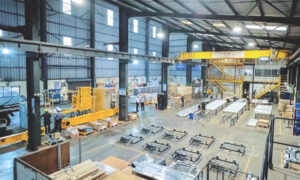A recent MIT study examines the opposing significance of natural gas in the battle against climate change as a bridge toward a lower-emissions future, but also a contributor to greenhouse gas emissions.
Natural gas, which is mostly methane, is viewed as a significant “bridge fuel” to help the world move away from the greenhouse gas emissions of fossil fuels, since burning natural gas for electricity produces about half as much carbon dioxide as burning coal. But methane is itself a potent greenhouse gas and it currently leaks from production wells, storage tanks, pipelines, and urban distribution pipes for natural gas. Increasing its usage, as a strategy for decarbonising the electricity supply, will also increase the potential for such “fugitive” methane emissions, although there is great uncertainty about how much to expect. Recent studies have documented the difficulty in even measuring today’s emissions levels.
This uncertainty adds to the difficulty of assessing natural gas’ role as a bridge to a net-zero-carbon energy system, and in knowing when to transition away from it. But strategic choices must be made now about whether to invest in natural gas infrastructure. This inspired MIT researchers to quantify timelines for cleaning up natural gas infrastructure in the United States or accelerating a shift away from it, while recognising the uncertainty about fugitive methane emissions.
The study shows that in order for natural gas to be a major component of the nation’s effort to meet greenhouse gas reduction targets over the coming decade, present methods of controlling methane leakage would have to improve by anywhere from 30 to 90 percent. Given current difficulties in monitoring methane, achieving those levels of reduction may be a challenge. Methane is a valuable commodity, and therefore companies producing, storing, and distributing it already have some incentive to minimise its losses. However, despite this, even intentional natural gas venting and flaring (emitting carbon dioxide) continues.
The study also finds policies that favour moving directly to carbon-free power sources, such as wind, solar, and nuclear, could meet the emissions targets without requiring such improvements in leakage mitigation, even though natural gas use would still be a significant part of the energy mix.
The researchers compared several different scenarios for curbing methane from the electric generation system in order to meet a target for 2030 of a 32 percent cut in carbon dioxide-equivalent emissions relative to 2005 levels, which is consistent with past U.S. commitments to mitigate climate change. The findings appear today in the journal Environmental Research Letters, in a paper by MIT post doc Magdalena Klemun and Associate Professor Jessika Trancik.
Methane is a much stronger greenhouse gas than carbon dioxide, although how much more depends on the timeframe you choose to look at. Although methane traps heat much more, it doesn’t last as long once it’s in the atmosphere — for decades, not centuries. When averaged over a 100-year timeline, which is the comparison most widely used, methane is approximately 25 times more powerful than carbon dioxide. But averaged over a 20-year period, it is 86 times stronger.
The actual leakage rates associated with the use of methane are widely distributed, highly variable, and very hard to pin down. Using figures from a variety of sources, the researchers found the overall range to be somewhere between 1.5 percent and 4.9 percent of the amount of gas produced and distributed. Some of this happens right at the wells, some occurs during processing and from storage tanks, and some is from the distribution system. Thus, a variety of different kinds of monitoring systems and mitigation measures may be needed to address the different conditions.
“Fugitive emissions can be escaping all the way from where natural gas is being extracted and produced, all the way along to the end user,” Trancik says. “It’s difficult and expensive to monitor it along the way.”
That in itself poses a challenge. “An important thing to keep in mind when thinking about greenhouse gases,” she says, “is that the difficulty in tracking and measuring methane is itself a risk.” If researchers are unsure how much there is and where it is, it’s hard for policymakers to formulate effective strategies to mitigate it. This study’s approach is to embrace the uncertainty instead of being hamstrung by it, Trancik says: The uncertainty itself should inform current strategies, the authors say, by motivating investments in leak detection to reduce uncertainty, or a faster transition away from natural gas.
“Emissions rates for the same type of equipment, in the same year, can vary significantly,” adds Klemun. “It can vary depending on which time of day you measure it, or which time of year. There are a lot of factors.”
Much attention has focused on so-called “super-emitters,” but even these can be difficult to track down. “In many data sets, a small fraction of point sources contributes disproportionately to overall emissions,” Klemun says. “If it were easy to predict where these occur, and if we better understood why, detection and repair programs could become more targeted.” But achieving this will require additional data with high spatial resolution, covering wide areas and many segments of the supply chain, she says.
The researchers looked at the whole range of uncertainties, from how much methane is escaping to how to characterise its climate impacts, under a variety of different scenarios. One approach places strong emphasis on replacing coal-fired plants with natural gas, for example; others increase investment in zero-carbon sources while still maintaining a role for natural gas.
In the first approach, methane emissions from the U.S. power sector would need to be reduced by 30 to 90 percent from today’s levels by 2030, along with a 20 percent reduction in carbon dioxide. Alternatively, that target could be met through even greater carbon dioxide reductions, such as through faster expansion of low-carbon electricity, without requiring any reductions in natural gas leakage rates. The higher end of the published ranges reflects greater emphasis on methane’s short-term warming contribution.
One question raised by the study is how much to invest in developing technologies and infrastructure for safely expanding natural gas use, given the difficulties in measuring and mitigating methane emissions, and given that virtually all scenarios for meeting greenhouse gas reduction targets call for ultimately phasing out natural gas that doesn’t include carbon capture and storage by mid-century. “A certain amount of investment probably makes sense to improve and make use of current infrastructure, but if you’re interested in really deep reduction targets, our results make it harder to make a case for that expansion right now,” Trancik says.
The detailed analysis in this study should provide guidance for local and regional regulators as well as policymakers all the way to federal agencies, they say. The insights also apply to other economies relying on natural gas. The best choices and exact timelines are likely to vary depending on local circumstances, but the study frames the issue by examining a variety of possibilities that include the extremes in both directions, that is, toward investing mostly in improving the natural gas infrastructure while expanding its use, or accelerating a move away from it.
Cookie Consent
We use cookies to personalize your experience. By continuing to visit this website you agree to our Terms & Conditions, Privacy Policy and Cookie Policy.















